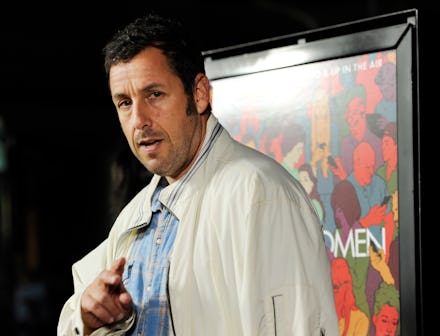Why the Adam Sandler Racist Movie Protest Is Actually a Big Deal

A dozen Native actors walked off the set of Adam Sandler's movie Wednesday upon realizing 1) the movie was really racist and presumably 2) that they were in an Adam Sandler movie.
The performers were hired as extras for The Ridiculous Six — a parody of the 1960 Western The Magnificent Seven — after producers assured them the film would definitely "not be racist," Indian Country Today Media Network reports. Naturally, they were surprised when characters named Beaver's Breath and No Bra popped up in the script, along with a scene featuring an Apache woman "squatting and urinating while smoking a peace pipe."
Actor Loren Anthony told the media network, "We were supposed to be Apache, but it was really stereotypical and we did not look Apache at all. We looked more like Comanche."
It's not too surprising that Sandler, whose 2014 film Blended was deemed "grotesquely offensive" and likened to a "minstrel show" by the New Yorker would feature such heinous stereotypes. But the fact that the actors walked off in protest is quite remarkable.
It's remarkable because, for most of American film history, Native performers in Hollywood didn't have much of a choice. If they wanted to work in the industry, the roles that were available to them fell persistently into a set of tired, offensive tropes — "stoic Indians," "bloodthirsty warriors," "magical medicine men" and "beautiful Indian maidens" important only insofar as they titillated and fueled the sexual imagination of (usually white) male characters.
And that's if these actors found work at all. Much of the time, "Indians" were actually played by white performers in red face paint, in films ranging from 1956's The Searchers to Johnny Depp's controversial turn as Tonto in the 2013 movie adaptation of The Lone Ranger. In The Searchers, extras who actually were of Native descent got paid less than the white actors in the film and "were not even allowed to leave the reservation without written permission from the government," the Huffington Post reports.
To say these patterns belong to an archaic but thankfully long gone past would be misleading. Things haven't changed all that much. But hope lives in a bourgeoning indigenous film scene, which in the past decade, has produced a series of works that bring nuanced, diverse and perhaps most notably, non-stereotypical portrayals of Native people to the screen.
Mic has written about these films before: Rhymes for Young Ghouls, a revenge fantasy set in Canada in the 1970s; The Activist, a historical drama about the 1973 occupation of Wounded Knee; Winter in the Blood, a literary adaptation set in modern Montana; and numerous others. All arrive in a social-media driven era of renewed attention, art and activism around Native issues. And all provide an important alternative to the racist fare Hollywood has continuously fed viewers for the past century.
That the Native actors and consultants on Sandler's film set felt empowered to walk away from a racist work environment is a powerful testament to these changes. The systemic problem of racist Native portrayals still exists, of course, but a cultural environment that prompts them to say, "No more — we're not doing this," is one to take heart in.
As if we needed another reason to avoid seeing a Sandler film.